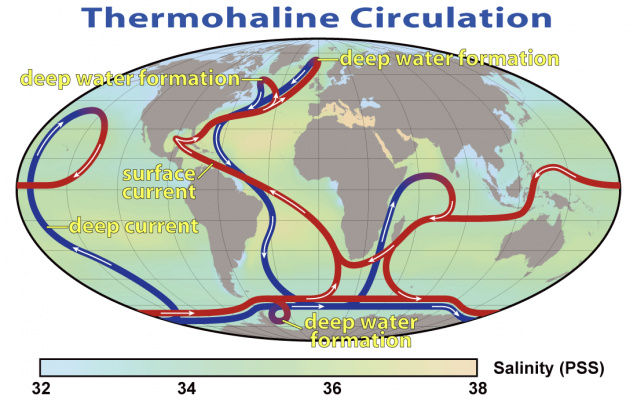What will happen to the Gulf stream as climate changes? Will this affect the climate in Finland?
Traditionally the term ‘Gulf Stream’ is used to denote the strong, horizontal surface ocean current which flows near the coast of the USA, from Florida to North Carolina. According to this definition the Gulf Stream is a wind-driven current that is not substantially changing due to climate change and does not affect the climate in Finland.
However, the Atlantic Meridional Overturning Circulation (AMOC) is sometimes popularly called the Gulf Stream System and I suppose the questioner actually means the AMOC rather than the Gulf Stream. In this case, according to climate projections, it is very likely that the AMOC will somewhat weaken over the 21st century and it is very unlikely that the AMOC will undergo an abrupt transition or collapse in the 21st century. Over these timescales the projected changes of the AMOC will not substantially affect the climate in Finland.
Based on the documentary “Before The Flood” (2016), I understood Europe might get colder and the weather more extreme due to changes in the Atlantic streams. It was not presented as an unlikely scenario, as far as I remember.
Was that purely misinformation, or outdated information? Or, would the effects be significant only in Western Europe, but not in Finland?
This scenario appears to be from the interview of Piers Sellers who was a NASA scientist and astronaut, and participated in making the documentary Before the Flood. He says: “This current… the dumping of ice off Greenland could stop this conveyor belt and the Gulf Stream would slow down and stop its transport of heat from here to there and then Europe would get cold toes because there is a lot of heat transport from across the tropics, across the north Atlantic that keeps Europe warm.” (See Figure 1 for the ocean circulation system.)

Figure 1. The global ocean circulation system, the so called Thermohaline Circulation. The circulation is driven by ocean water density and salinity differences. It is the main distribution of energy in the whole Earth ocean-climate system. AMOC/Gulf stream is the northest part of the circulation in the Atlantic Ocean.
According to the IPCC Special Report on the Ocean and Cryosphere in a Changing Climate published in 2019, this scenario is very unlikely (medium confidence) in the 21st century, although becomes by 2300 as likely as not for high emissions scenarios (RCPs), but stays very unlikely for lower emissions scenarios (medium confidence), see paragraph B.2.7 in the Summary for Policy Makers.
Quote from IPCC Special Report:
B.2.7. The AMOC is projected to weaken in the 21st century under all RCPs (very likely), although a collapse is very unlikely (medium confidence). Based on CMIP5 projections, by 2300, an AMOC collapse is about as likely as not for high emissions scenarios and very unlikely for lower ones (medium confidence). Any substantial weakening of the AMOC is projected to cause a decrease in marine productivity in the North Atlantic (medium confidence), more storms in Northern Europe (medium confidence), less Sahelian summer rainfall (high confidence) and South Asian summer rainfall (medium confidence), a reduced number of tropical cyclones in the Atlantic (medium confidence), and an increase in regional sea level along the northeast coast of North America (medium confidence). Such changes would be in addition to the global warming signal. {6.7, Figures 6.8–6.10}
So in summary: The AMOC (Gulf stream) is weakening as the climate warms, and it may affect the weather patterns in Europe and North America, but full collapse of the stream is very unlikely.
Glossary:
AMOC = Atlantic Meridional Overturning Circulation (Gulf stream is one part of it)
RCP = Representative Concentration Pathway (this means the different emission scenarios used in the IPCC report)
Further reading:
Recent increases in Arctic freshwater flux affects Labrador Sea convection and Atlantic overturning circulation (article in Nature Communications in 2016, open access)
https://www.nature.com/articles/ncomms10525

